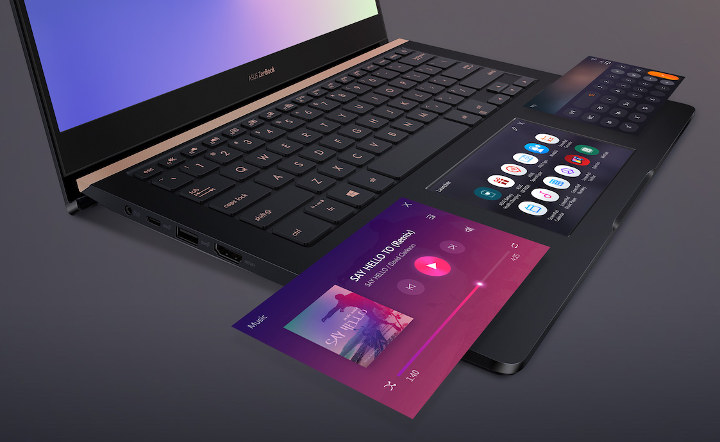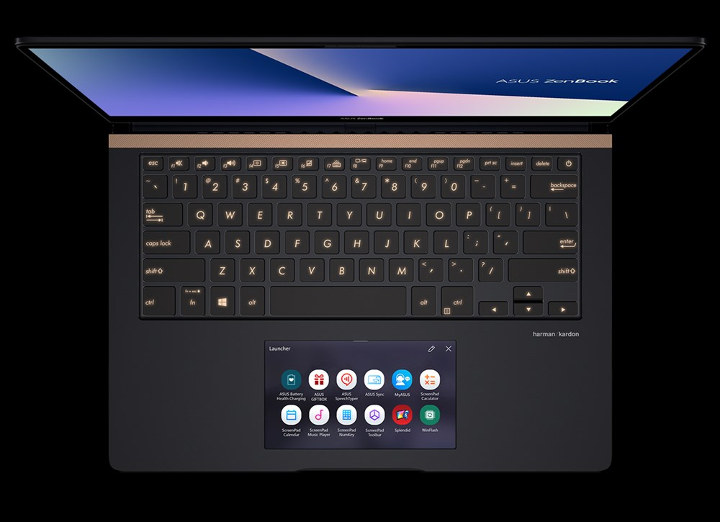Touchpads is a feature found in most laptops, but AFAIK there’s not been much innovation recently apart from maybe support for multitouch and gestures. But I’ve just found out ASUS started to showcase laptops without touchpad a few months ago, instead integrating what the company calls a ScreenPad, a 5.5″ touchscreen display placed at the location where you’d normally expect a touchpad.
The company’s latest (and second) laptop with a ScreenPad is Asus ZenBook Pro 14 UX480FD, which comes with a 14″ display, processor up to an Intel Core i7-8565U Whiskey Lake-U processor, up to 16GB DDR4 RAM, and up to 1TB PCIe SSD storage, as well as an NVIDIA GeForce GTX 1050 Max-Q graphics, 802.11ac WiFi, Bluetooth 5.0, and more. You can visit the product page for the full specs, as I’ll focus a bit more on the ScreenPad in this post.
The ScreenPad in this laptop is a 5.5” FHD (1920 x 1080) Super IPS+ display, with 178 wide-view technology, glass-covered for fingerprint and smudge resistance, and featuring precision touchpad (PTP) technology supporting up to four-finger smart gestures.
 Pressing the F6 key on the keyboard will switch to three modes for the ScreenPad:
Pressing the F6 key on the keyboard will switch to three modes for the ScreenPad:
- ScreenPad mode – This mode gives you access to ScreenPad apps with a launcher, a toolbar, a music player, a YouTube based online video player, calculator, calendar, ScreenPad Office working with Word, Excel and PowerPoint, and other apps that can be installed via an app store.
- Screen Extender mode – The ScreenPad just acts as a small secondary display, which could be used to keep an eye on emails or social media feeds for example.
- Touchpad mode – Acting as a standard multitouch, gesture capable touchpad
ASUS has posted a short tutorial video that describes clearly what can be done with the ScreenPad.
That looks interesting, but that’s probably one of those things you have to experience yourself to find out if it’s just a gimmick, or really help with your workflow. Pressing F6 does not look overly convenient though, especially if you switch between touchpad and ScreenPad mode frequently. A button on the side of the small display may have been more user-friendly. If you ever wanted to install Ubuntu or another Linux distribution on such laptop, support for ScreenPad would likely be another hurdle. Do you think those will become more prevalent, or the traditional and cheaper touchpads still have a long life ahead?
Speaking about pricing, we still don’t know how much the Zenbook Pro 14 UX480FD model will go for, but the earlier – and more powerful – Zenbook Pro 15 is said to cost $1,799 and up depending on configuration. Neither models appear to be for sale online right now.
Via Liliputing

Jean-Luc started CNX Software in 2010 as a part-time endeavor, before quitting his job as a software engineering manager, and starting to write daily news, and reviews full time later in 2011.
Support CNX Software! Donate via cryptocurrencies, become a Patron on Patreon, or purchase goods on Amazon or Aliexpress





